
 |
Newer buildingsPhotographed in January & February 2004 |
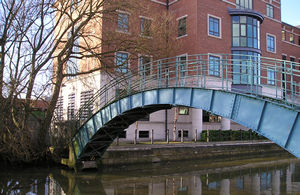 |
Ooh, it's gorgeous. The bridge, I mean, not the building behind it. Though I like the way the blue of the windows reflects the blue of the bridge. Or maybe it was the other way round, and they painted the bridge to match the building. I thought this was called the MAFF building, but in fact MAFF are now DEFRA, and this building, in any case, is officially called Foss House. |
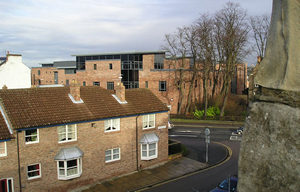 |
The houses in the foreground are fairly "new" by York standards, but the new building in question is the building in the background, to the left of the trees. St John's College "Fountains Learning Centre" opened in September 2003. Taken from the bar walls, this is the least attractive view of what is actually a stunning new building. Better photos of its Clarence Street facade may follow. |
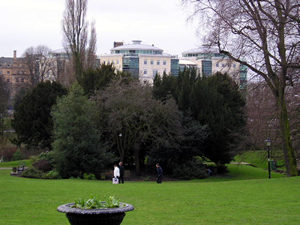 |
View across the Museum Gardens to the luxury Westgate Apartments on Leeman Road, completed in late 2002. Though it sounds as if some problems have ensued, since this building was "finished". A story in the local press mentioned that "Some apartments have been affected by water ingress" – which is a rather poetic way of saying that some people have leaks in their expensive apartments. (Full story: Defects hitch on luxury homes)
|
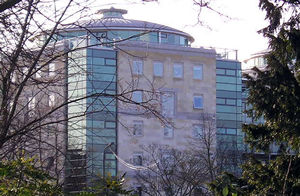 |
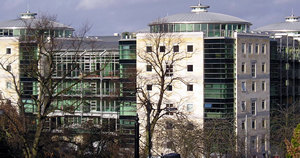 |
|
Above: Westgate apartments, from the Museum Gardens (left) and from the bar walls (right). |
|
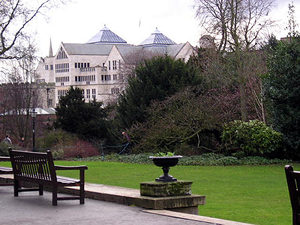 |
This building, visible behind the trees of the Museum Gardens, is around ten years old, and is apparently called Wellington Row. It's a handsome building and this photo doesn't do it justice. It looks most impressive if you approach it from under the arches of Lendal Bridge, on the riverside path, on a sunny morning in summer, when it looms above you in all its golden loveliness. I know that not everyone admires it. I think I just like the way the pale-coloured stone reflects the light. Everything else they're building is new red brick. |
|
On a later wander, on 1 February, I took these photos below of the same building, from close by, on the riverside by Lendal Bridge. |
|
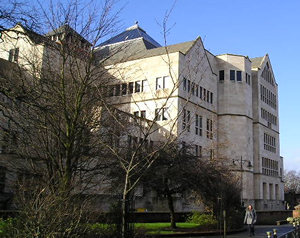 |
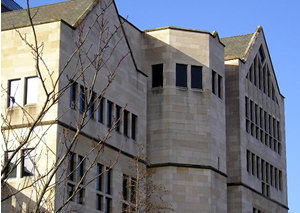 |
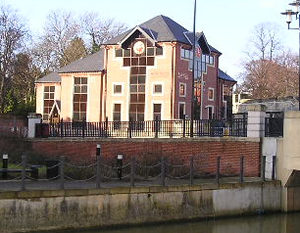 |
This is a fairly recent construction (completed in 2000, I believe), by Layerthorpe Bridge. Apparently it's called Sentinel House, and was referred to in our local paper as "imposing". Afraid I can't agree – seems a bit bland really and I can't think of anything to say about it, except that I wish I'd recorded on camera what they knocked down to build it, as I'm sure it was more interesting. |
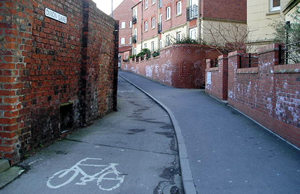 |
I'd not been up Piccadilly way for some years, at least not in the daylight while paying attention, so it was a shock to see the buildings on the right of this picture – another residential development. From memory, both sides of this narrow lane were once that nice old weathered brick shown on the left side, and you left the ugly views of Piccadilly behind, to walk between two high walls. |
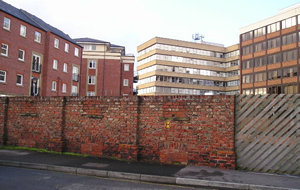 |
If you follow Dixon Lane as shown in the above photo, then turned left when you got to the top, and look back, this is the view back towards Piccadilly. The buildings on Piccadilly are generally ugly, particularly the Ryedale Building in the centre. Piccadilly is one of the few York streets constructed in the 20th century, with buildings to match. |
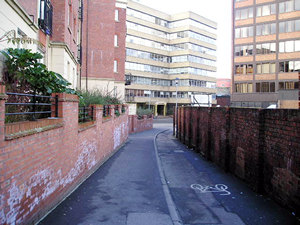 |
In the Esher report, David Lloyd suggests that the street has 'scarcely any positive visual qualities' and comments on its 'subtopian' effect, and 'the recession into nothingness of Piccadilly'. Esher himself says 'Piccadilly has cut through the workshop hinterland with a swathe of garages and new office blocks forming the least attractive of all the entries into the city.' I don't think they liked it. And neither do the rest of us, decades on. |
|
And the best quote of all, as it's so damning, but in such a measured way: 'The walled city contains two twentieth-century streets,
Piccadilly (1912) and Stonebow (1960), and their visual characteristics
are sufficient commentary on the national loss of touch which has led
to the need for this Report.' Related pages: York Walks /2: Stonebow and Hungate. Some of the city's other more recent buildings feature on other pages. New developments can be seen on Skeldergate (York Walks /1) and Queen's Staith, and around the Aldwark and Bedern area (York Walks /2). |
|